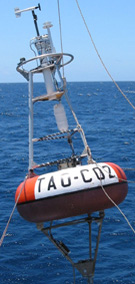Background
Mission Statement
Projects

|
Background:
Upwelling in the equatorial Pacific leads to enhanced productivity and degassing of CO2 across a region ranging from the coast of South America to past the international dateline. The vast area affected makes this region a significant component of the global biogeochemical cycle. The magnitude of the primary productivity signal resulting from this upwelling is relatively low due to iron limitation, thus much of the CO2 brought to the surface is released to the atmosphere through gas exchange. Since December 1996, MBARI has collaborated with PMEL to maintain pCO2 sensors on two TAO moorings in the equatorial Pacific funded as part of NOAA’s Global Carbon Cycle (GCC) program. These moored observations are important because this region exhibits strong seasonal, interannual and likely multi-decadal variability. For example, during 1997 and early 1998 this region was perturbed by the largest El Niño event this century. Surface waters became oligotrophic, surface chlorophyll concentrations were the lowest on record, and the region became a weak sink of CO2, in contrast to its normal status as the largest natural source of CO2 to the atmosphere. In April 1998, a dramatic recovery was initiated and the system became highly productive, analogous to coastal environments. High chlorophyll levels were observed over an unprecedentedly large area and CO2 flux out of the ocean was again high. These large chemical and ecological changes were linked to changes in the upwelling of nutrient-enriched waters, caused initially by the passage of downwelling Kelvin waves, and then more dramatically by the cessation of the trade winds and the associated upwelling. The description and quantification of these dynamic changes would not have been possible without observations from moorings. Since the 1997-98 El Niño the equatorial Pacific has been unusually cool, perhaps indicating a longer term change. In 2003, two additional pCO2 sensors were added to TAO moorings at 125°W, 0° and 140°W, 0° to better constrain the location and timing of the El Niño effects on air-sea CO2 gas exchange in the equatorial Pacific. In 2004 the moored pCO2 program was transferred to NOAA’s Climate Program to become part of the climate observation network. We are currently working to expand the network to the global oceans.
|
